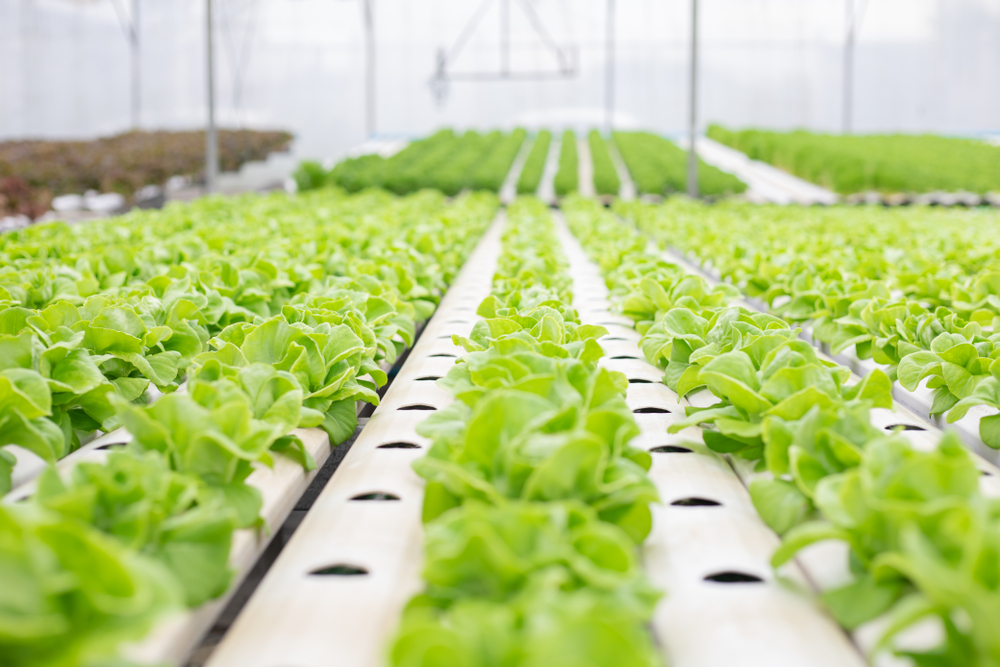Subtracting soil from the equation and replacing it with nutrient-rich water is the goal of hydroponics.
Drip or ebb and flow systems deliver nutrients to the roots, which are usually embedded in a support media such as perlite to expanded clay.
Some of these help mediums are extensively used and come in a variety of price and benefit categories.
To ensure that the pH in this contained ecosphere does not fluctuate outside of the acceptable range, they help the plants by aiding in nutrient uptake and water retention.
The aquarium gravel works almost flawlessly once it’s not submerged in water, else it may cause PH fluctuations.
Because of its affordability and accessibility, it’s a fantastic medium. Because it’s small, it often gets tangled with the plant roots.
That makes it unnecessary to remove and clean since it’s already so inexpensive.
Table of Contents
Can I Use Aquarium Gravel for Hydroponics?

Aquarium gravel can have a significant impact on whether or not there is a good crop or a poor one.
Gravel is an underutilized building material.
Many hydro culturists don’t choose it as their first option.
However, it has several advantages, the most vital one being its low price, ready availability, and long-term usability.
In the opinion of many hydroponic growers, it is worthwhile to use it solely as a substrate.
What Are Some Benefits and Drawbacks of Using Gravel for Hydroponics?
Water does not absorb, pH neutral, reusable, and high aeration are all characteristics of the preferred hydroponic support medium.
In addition to these qualities, gravel comes in a variety of shapes and sizes.
If you want to grow plants in hydroponics, you can choose between two types of gravel: sharp and pea.
Which type of gravel you use is entirely up to personal preference. To avoid clogging any pumps that may be used, it is best to properly wash any gravel that has been used in the project.
As a base, between 3/8 and 5/8 of the blend of both is ideal; the two are unique in that one has circular edges while the other has pointy ones.

How Does Combining Gravel Benefit Hydroponics?
This screening combination permits items to slip through and provide nutrients to the roots that are hanging down.
The crops would starve to death if the gravel was packed too tightly, preventing nutrients from flowing freely to the plants.
As nutrients run over the gravel’s surface, the sharper particles of gravel prefer to cling to them.
This is significant since nutrients are held between the small, jagged cracks, and the process helps preserve the plants between irrigations.
Roots have a better chance of clinging to a rougher rock for stability than they would on a smooth one.
When water flows over the gravel, it doesn’t shift because of the rougher surfaces’ ability to keep it in place.
Do You Need to Clean the Gravel for Hydroponics?
Occasionally, it is necessary to clean the gravel itself. In contrast to other substrates that you’ll need to dispose of and restore after harvest, gravel can be removed from the growing bed.
Washing away any unwanted material that has adhered to surfaces is a simple process.

Once the gravel has been thoroughly cleaned and sanitized, it is ready to be used for the upcoming planting cycle.
Repetition of this procedure reduces the amount of aggregate that must be transported to the job site, saving both time and money.
Significance of Gravel Weight in Hydroponics
Gravel’s weight is an issue during shipment as well as setup, which will have an impact on the hydroponic system’s structural design.
Hydroponic farms require a planting structure that can hold the burden of the gravel substrate as well as water for an extended length of time, and this weight-bearing equation must be taken into consideration.
The pH Value of Hydroponic Gravel
Recalibrating the pH in hydroponics and aquaponics is required regularly to keep it within the desired range.
The sort of gravel stone used can impact the pH level and raise it above the acceptable range, causing this chemical reaction to occur.
If that occurs, it could damage the plant’s ability to absorb nutrients as the water moves through the system.

Additionally, the water’s alkalinity or acidity might affect the pH consistency levels and how the stone interacts with this biological system.
Even with the correct equipment, the pH range can be hard to control if the liquid has an excessive amount of alkalinity, and trying to retain balance can prove to be a costly affair.
What Happens if the Water Source is Too Acidic?
A water source that is too acidic, on the other hand, can benefit from the gravel, which can balance out the imbalance.
There are many factors to consider when selecting gravel for a hydroponic system, such as what sort of water will be utilized and how it will affect the pH balance of that water.
Does the Nonporous State of Gravel Affect Hydroponics?
Because gravel is nonporous, it is unable to retain water on its own. This is not an issue with a drip irrigation system, because the water flow is quite steady.
In the event of a blackout or a clog in one of the pipes, a safety mechanism may be necessary if the water and drainage method is used.
Because of this, the watering cycle must be more regular when using gravel, otherwise, the roots may dry out and die.

It’s also important to consider the thickness of the stones.
How Shallow Gravel Affects Hydroponics
It can have a significant impact on the growth of the plant’s roots. Gravel that is too shallow can inhibit the root’s ability to grow.
Fungus gnats will love eating on the base of the crops when the gravel is much too thin, and this can lead to an algae layer forming on the surface.
A depth of at least 50 millimeters will prevent this buildup since light cannot reach that deep and mix with the wetness to let the algae thrive.
In Aquaponics, What Is the “Grow Media”?
Your plants’ bodies are supported by aquaponics growth media, an organic or inorganic solution that does not include any dirt.
It shields and guarantees that plant roots are developed in the correct position like dirt.
Besides serving as a surface for bacteria growth, the medium also acts as a buffer for fish tank waste that is evacuated and deposited into the growing medium.
In addition, not all aquaponics techniques use aquaponics growth media, such as the raft system as well as NFT, in which crops are grown in drifting rafts and PVC tubes.

Aquaponics Buying Guide: What to Seek
A variety of aquaponics growth media are available for your system, each with advantages and disadvantages.
Many things must be taken into account for your aquaponics system to be a success and for you to select the proper growing media for your system.
pH-Neutral
You should check and adjust the pH level of your hydroponic system regularly. Your system’s pH must be within an acceptable range.
Because of this, it is critical to use pH-neutral growth media. You’ll be able to better control the pH of your system if you use a pH-neutral growth material.
A pH test is a good idea if you want to use gravel or lava rock in your project. Place your medium in a jar and add vinegar to it to see if the solution works.
If you observe bubbles in your growing medium, it indicates that it has a high pH. If there are no bubbles, it signifies your growth material is pH neutral.
Weight

When deciding on a medium, consider the weight of the item. Make sure that your aquaponic medium isn’t too heavy or bulky if you have small or frail bed configurations.
If the weight of your growing bed is too much for your system, it could fall apart.
Because too light or too thick of a growing medium can float and clog your system, go with something in the middle if you don’t want it to become unmanageable.
Size
If your growing medium is too small, you run the risk of clogging your system. Excessively big media can lead to air gaps, which can negatively impact plant growth.
Aquaponics’ suggested growing media range from 12″ to 34″ in diameter, with a sufficient surface area for bacterial colonization.
Comfortable for Your Hands
Your hands will come into contact with the growing medium when you plant your plants. It’s possible to cut your hands when tending to your growing bed if your growing material is too sharp.
Choosing growing media that are safe and easy to handle is essential.
The Price

If you’re just getting started with aquaponics, you’ll want to keep an eye on your budget. The cost of aquaponics growing medium varies according to the type you choose.
Hydroton, for example, is more expensive than gravel. Before selecting a growing medium, it’s a good idea to figure out your budget.
Suggestions to Help You Get Started with Hydroponics
Vinegar can be used to assess your growing material if hydroton is not used. After carefully cleaning your growing medium with water, place everything in a vessel and add an appropriate amount of vinegar.
Bubbles are a sign that the pH level is high. The vinegar reacts with limestone to produce bubbling.
To prevent the growth of algae, contain a minimum of 2″ of dry material in the tank. The suggested depth of the growing material is 12 inches, but you should put an additional 2″ above to avoid the growth of algae or fungi.
To avoid choking your grow surface, discard sediments and other trash from the growing media once every year.
This can lead to anaerobic areas that destroy beneficial microorganisms in the grow bed. The nitrification action will be slowed, and the pH of your system will rise as a result of a congested grow bed.
High pH levels are an indication that the grow bed has become blocked.
Aquarium Gravel for Hydroponics: The Bottom Line

In an ebb and flow irrigation system, gravel is appropriate as a support medium because the aggregate gets watered multiple times a day.
Water cannot be held or absorbed by it, however, the low price and ease with which it can be obtained locally make up for this shortcoming.
Consider that the gravel you choose must be chemically sterile, thus limestone should be avoided because it will alter the pH of the habitat.
There’s nothing worse than saving money by using a less expensive support medium, only to find yourself saddled with extra work due to the need to regularly adjust the ph levels.
Hydroponic farming may appear to be a soilless activity, but the actual truth is that it might be the beginning of a new revolution in sustainable farming, ushering in a new method of feeding the globe.
After all, who wouldn’t want to be able to produce a greater quantity of food in a shorter period under more precise conditions?

















